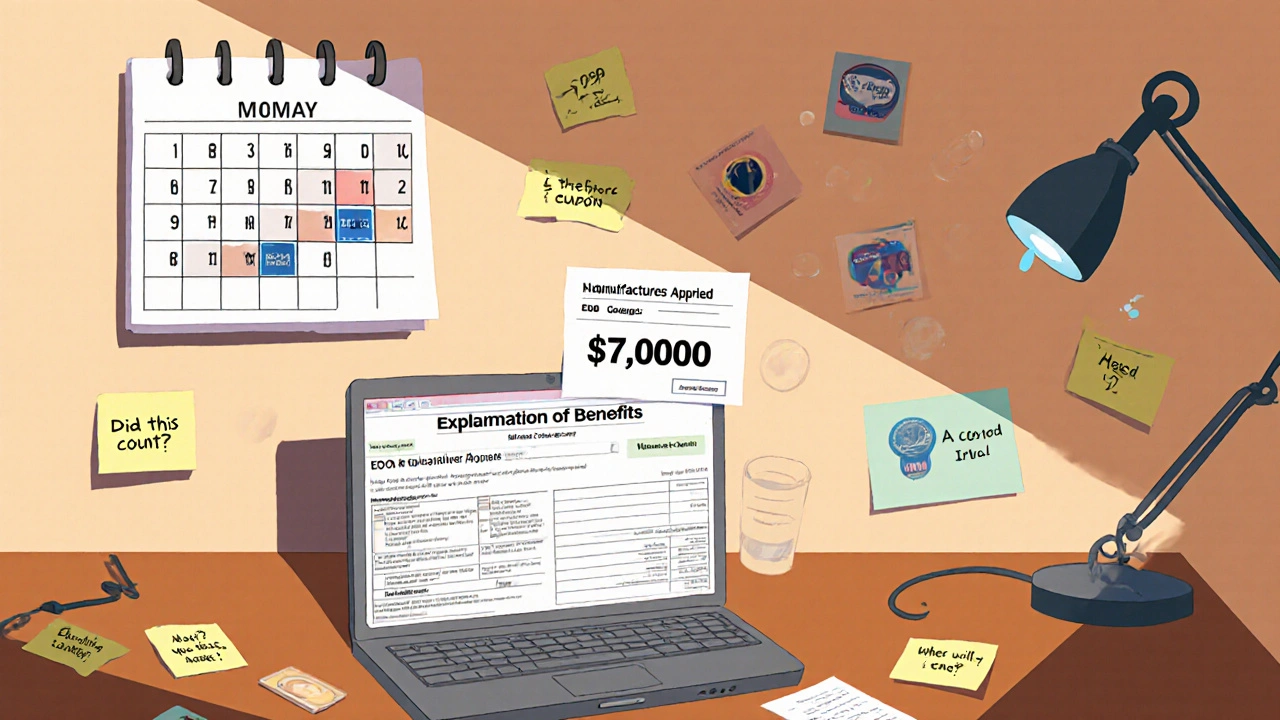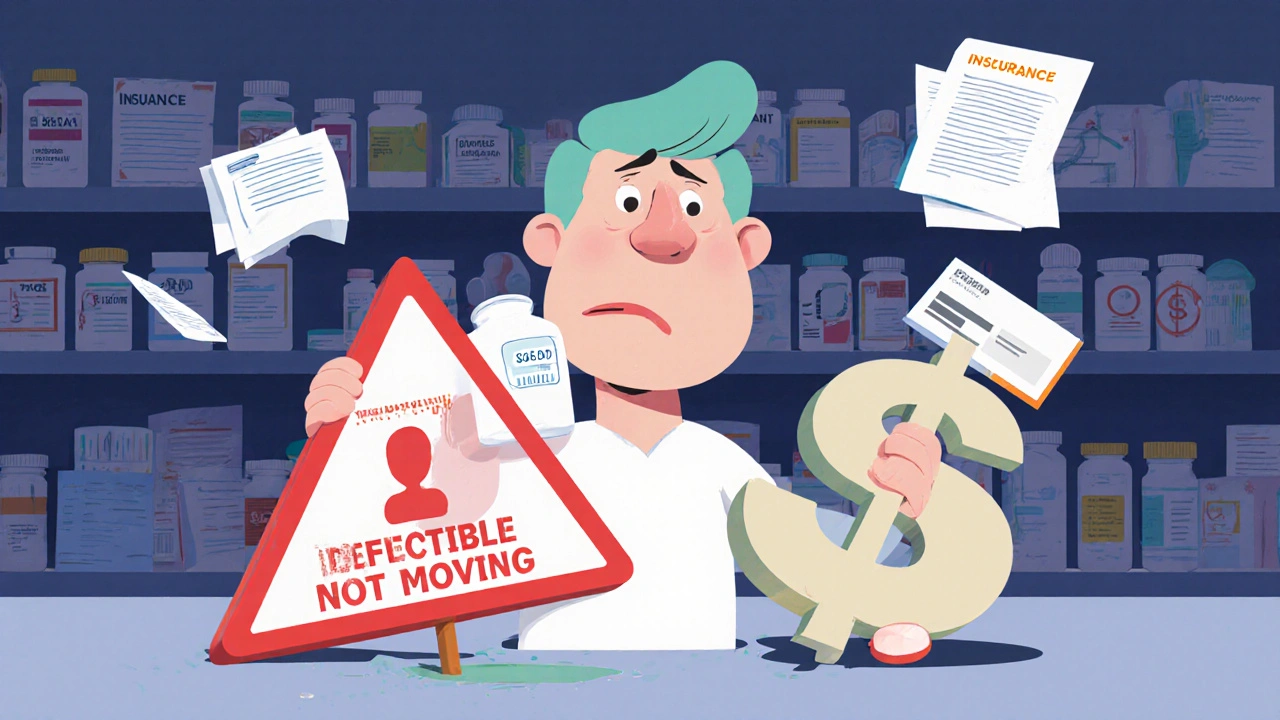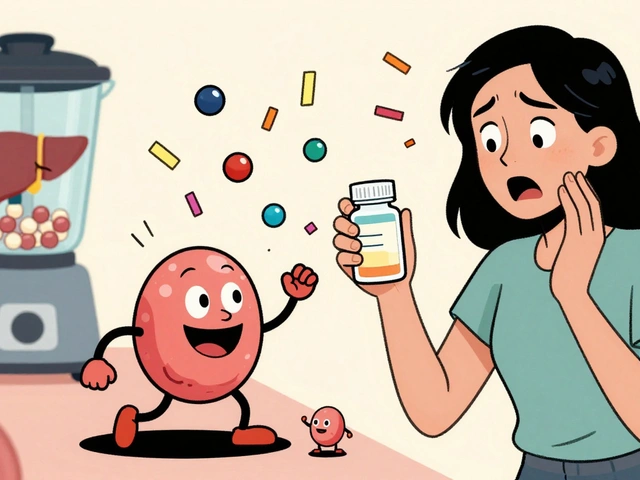When you’re managing a chronic condition like multiple sclerosis, rheumatoid arthritis, or Crohn’s disease, your medication isn’t just a pill-it’s your lifeline. But when that pill costs $7,000 a month, even the best insurance can leave you stranded. That’s where copay cards come in. These cards, offered by drug manufacturers, promise to slash your out-of-pocket costs, sometimes down to just $5 or $10 per prescription. For many, they’re the only reason they can stay on treatment. But here’s the hidden risk: what happens when the card runs out? And more importantly, did your insurance ever count that help toward your deductible? If not, you could be facing thousands in unexpected bills-and possibly forced to stop your medicine.
How Copay Cards Actually Work
Copay cards are coupons issued by pharmaceutical companies to help commercially insured patients pay for expensive specialty drugs. They’re not discounts you get at the pharmacy counter like a coupon for shampoo. Instead, when you hand over your insurance card and the copay card, the manufacturer pays the difference between what your insurance says you owe and the full price of the drug. For example, if your drug costs $8,000 a month and your insurance says you owe $2,000, the card might cover $1,900, leaving you with just $100.
These programs are designed to improve adherence. According to a 2023 NIH study, 93% of patients using copay cards say they’ve been able to stick with their treatment because of the savings. That’s huge. For people with autoimmune diseases or cancer, missing even one dose can mean worsening symptoms or hospitalization.
But there’s a catch. These cards only work if you have private insurance-Medicare, Medicaid, and other government programs are legally barred from accepting them. And even among private insurers, not all plans treat these cards the same way anymore.
The Hidden Trap: Copay Accumulator Programs
Starting around 2016, insurance companies began rolling out something called copay accumulator programs. These programs sound harmless-they say they’re just making sure manufacturer discounts don’t inflate your deductible. But here’s what really happens: when you use a copay card, the money the manufacturer pays doesn’t count toward your deductible or out-of-pocket maximum. Only the money you pay counts.
Let’s say your plan has a $7,000 deductible. You’re on a drug that costs $7,500 a month. Your copay card covers $7,000 of it each month, so you pay $500. Under a traditional plan, those $7,000 from the card would count toward your deductible. In just 10 months, you’d hit your $7,000 cap and pay nothing after that.
But under an accumulator program, those $7,000 don’t count. You still owe $7,000. So even though you’ve paid $6,000 out of your own pocket over a year (at $500/month), your deductible is still at $7,000. When your copay card runs out-or if the manufacturer caps it at $20,000 per year-you suddenly face a $7,000 bill you didn’t know you were building up.
This isn’t hypothetical. A patient on the National MS Society forum shared: “After two years of paying $10 a month, I found out my deductible was still $7,000. I had to stop my meds for three months.” That’s the kind of shock that leads to treatment abandonment.
Copay Maximizers: Another Silent Risk
Some insurers don’t just ignore the manufacturer’s payment-they use it to your disadvantage. Enter copay maximizer programs. These programs set your copay to match the maximum amount the manufacturer will pay. So if your drug costs $8,000 and the card covers up to $7,500, your pharmacy will charge you exactly $500 every month-even if the actual price drops. That $500 doesn’t count toward your deductible either. You’re paying the same amount, but you’re not getting closer to coverage.
Why do insurers do this? Because it makes the drug look cheaper to them. The manufacturer pays more, and the insurer pays less. But you’re stuck paying the same high monthly amount with no end in sight. And if your card expires, you’re still facing the full cost-because your deductible hasn’t moved.

Who’s Affected-and Who’s Not
Not everyone is at risk. If you have a low-deductible plan, or if you only need your medication for a short time (like a 6-month course of treatment), copay cards work beautifully. In fact, 45% of patients in one study completed their full treatment because of these cards.
But if you’re on long-term therapy-especially for autoimmune, cancer, or rare disease conditions-you’re in the danger zone. The average patient on biologic drugs takes 4.2 months to even understand how their accumulator program works. By then, they’ve already paid thousands without realizing they’re not getting closer to coverage.
And here’s the kicker: 78% of large commercial insurers now use accumulator programs. That’s up from just 8% in 2018. Self-insured employer plans-common in big companies-are even worse, with 67% using them. If you get insurance through your job, you’re more likely to be hit with this surprise.
How to Use Copay Cards Safely
You don’t have to be caught off guard. There are steps you can take to protect yourself.
- Ask your pharmacist: Before you fill your first prescription, say: “Does my plan have a copay accumulator or maximizer program?” Don’t assume they know. Many pharmacists don’t track this unless they’re trained to.
- Call your insurer: Ask: “Do manufacturer copay assistance payments count toward my deductible and out-of-pocket maximum?” Write down the name of the person you speak to and the date.
- Check your explanation of benefits (EOB): Look for lines that say “Manufacturer Coupon Applied” or “Third-Party Payment.” If it’s listed but your deductible hasn’t moved, you’re in an accumulator program.
- Ask about alternatives: If your card is running out, ask your doctor or pharmacist about patient assistance programs from charities, foundations, or the manufacturer’s direct aid program. Some offer help after the card expires.
- Track your progress: Keep a spreadsheet of how much you’ve paid, how much the card covered, and what your deductible balance is. Don’t rely on your insurer’s portal-they may not show the real picture.
Specialty pharmacies are starting to help. Some now send alerts when you’ve used 80% of your copay card benefit-giving you 60 days to plan ahead. But that’s not universal. You can’t wait for them to reach out.
What’s Changing-and When
There’s movement. In September 2024, the Department of Health and Human Services proposed a new rule: insurers must clearly explain accumulator programs during enrollment and send monthly statements showing your true deductible progress. That rule takes effect January 1, 2026. That’s two years away-and right now, you’re still in the wild west.
There’s also a bill in Congress-the Copay Accumulator Moratorium Act-that would ban these programs for three years. It has 72 bipartisan sponsors. But drugmakers are fighting back. PhRMA spent over $28 million lobbying against it in early 2024.
Meanwhile, CVS Caremark rolled out “transparency dashboards” in April 2024 to show patients their real deductible progress. But that’s only available to 28% of commercially insured Americans. You can’t count on it.
What You Can Do Right Now
If you’re on a specialty medication and using a copay card:
- Find out if your plan uses an accumulator or maximizer program today.
- Calculate how long your card will last and what your out-of-pocket bill will be after it expires.
- Talk to your doctor. Ask if there’s a lower-cost alternative, even if it’s not your first choice.
- Reach out to patient advocacy groups. Organizations like the National MS Society, Crohn’s & Colitis Foundation, and the Spondylitis Association of America have financial aid programs and can help you navigate this.
Don’t wait until you get a bill for $7,000. That’s when the panic starts. The system is rigged to hide the truth until it’s too late. But you can outsmart it-if you act before your card runs out.
Final Thought
Copay cards were meant to save lives. But when insurers change the rules without telling you, they turn a lifeline into a trap. You deserve to know the real cost of your treatment-not just the price on the card. Don’t let your care be compromised by fine print. Ask the questions. Track the numbers. And don’t assume anything.
Are copay cards free to use?
Yes, copay cards are free to use. They’re provided by drug manufacturers at no cost to the patient. However, they only work with private insurance and cannot be used with Medicare, Medicaid, or other government programs. The catch is that using them doesn’t always mean you’re reducing your overall costs-especially if your insurer uses a copay accumulator program.
Do copay cards count toward my deductible?
It depends on your insurance plan. If your plan has a copay accumulator program, the manufacturer’s payment does NOT count toward your deductible or out-of-pocket maximum. Only the money you pay out of pocket counts. If your plan doesn’t have an accumulator program, then yes, the manufacturer’s payment counts toward your limits. Always confirm this with your insurer before using the card.
How do I know if my plan has a copay accumulator program?
Call your insurance company and ask directly: “Do manufacturer copay assistance payments count toward my deductible and out-of-pocket maximum?” Don’t rely on your online portal or your pharmacist’s assumption. Ask for written confirmation. You can also check your Explanation of Benefits (EOB) statements-if you see “manufacturer coupon applied” but your deductible hasn’t changed, you’re in an accumulator program.
What should I do when my copay card expires?
Before your card runs out, contact your pharmacy, doctor, or patient advocacy group to explore alternatives. Many drug manufacturers offer direct patient assistance programs that continue support after the card ends. You may also qualify for aid from nonprofit foundations like the Patient Access Network (PAN) Foundation or the HealthWell Foundation. Don’t wait until you can’t afford your meds-plan ahead.
Can I use a copay card with Medicare?
No. Federal law prohibits copay cards from being used with Medicare, Medicaid, or any other government-funded health program. This is to prevent violations of the federal anti-kickback statute. If you’re on Medicare, you’ll need to look into other assistance options like Extra Help, Low-Income Subsidy (LIS), or manufacturer patient assistance programs that are designed for Medicare beneficiaries.






7 Comments
I was blindsided by this. I’ve been using my copay card for my MS meds for two years thinking I was getting closer to hitting my deductible. Turns out, my insurer’s been ignoring every penny the manufacturer paid. I just got a bill for $6,800 last month. I had to pause treatment for a month. Don’t assume anything. Ask. Now.
This is wild. In India we don’t even have these cards. Our meds are cheaper but harder to get. Still, the idea of a hidden trap like this is terrifying. You think you’re safe and then BAM you’re broke. No one warned me this could happen even in the US.
I work in pharmacy and let me tell you most patients have no idea what’s going on. I’ve seen people cry because they thought their copay card was ‘saving’ them. The truth? They’re being set up. Pharmacists aren’t trained to explain this. Insurance companies don’t care. It’s a system designed to look like help but actually just delays the pain.
You’re not alone. I’ve been there. Started tracking everything in a spreadsheet after I got hit with a $5k bill. Now I call my insurer every month and screenshot my EOB. It’s exhausting but it’s the only way. And if you’re on a long-term med-don’t wait. Ask now. Talk to your doc. Find a foundation. You’ve got this.
So basically… we’re all just lab rats in a Pharma vs Insurance death match?? 😭 I’m just here waiting for the next episode of ‘Who’s Going to Get Screwed This Month?’ I’m starting a Patreon for people who need help reading their EOBs. I’ll call it ‘Copay Carnage: The Series’ 🎬💸 #IWantMyDeductibleBack
It is of paramount importance that patients be afforded full disclosure regarding the operational mechanics of copay assistance programs and their interaction with insurance benefit structures. The absence of transparent communication constitutes a material breach of fiduciary duty on the part of both insurers and, in some cases, pharmaceutical entities. I urge all affected individuals to formally request written confirmation from their plan administrators and to retain all correspondence for potential regulatory or legal recourse. This is not merely a financial concern-it is a matter of healthcare equity and ethical obligation.
I keep thinking about how much trust we put in systems like this. We assume the people who sell us medicine care about us surviving. But this? This feels like being handed a life jacket that’s full of holes-and then being told, ‘Hey, you’re doing great, you’re not sinking!’ We’re not just patients. We’re people trying to live while the system plays chess with our health. It’s not just about money. It’s about dignity.